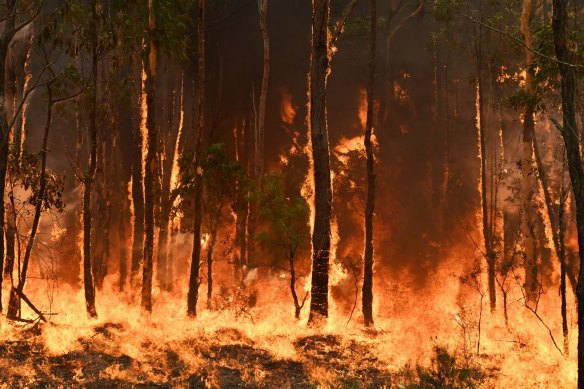Demystifying BAL Reports: An Overview to Comprehending Your Residential or commercial property's Bushfire Risk
Demystifying BAL Reports: An Overview to Comprehending Your Residential or commercial property's Bushfire Risk
Blog Article
Ensuring Shrub Fire Protection With Correct BAL Report Analysis
In the realm of bush fire protection, the meticulous evaluation of Bushfire Attack Level (BAL) reports stands as a cornerstone for protecting properties versus the disastrous influence of wildfires. With environmental variables and building characteristics playing considerable functions in determining the degree of threat, a detailed understanding of BAL scores ends up being important. Nevertheless, the actual essence exists not just in comprehending these reports yet in understanding them properly to formulate tailored fire defense techniques. By delving right into the importance of BAL report analysis, we reveal a realm where informed decisions lead the course towards reinforcing residential or commercial property security and resilience in fire-prone areas.
Recognizing Bushfire Attack Degree (BAL)
In the world of bushfire defense, comprehending the Bushfire Assault Level (BAL) is paramount for ensuring efficient reduction methods. Comprehending the BAL rating of a home is crucial for property builders, policymakers, and owners to apply proper steps to protect versus bushfire dangers.

Importance of BAL Record Evaluation
A crucial aspect in bushfire protection planning includes the thorough analysis of BAL reports to examine the prospective risks and figure out suitable reduction methods. BAL reports give crucial details concerning the possible influence of bushfires on a building based upon various elements such as plant life type, range to prospective fire dangers, and incline of the land. Examining these reports with precision is extremely important in creating effective bushfire protection measures tailored to the particular risk profile of a home.
Carrying Out Fire Protection Steps
Carrying out reliable fire defense steps is important for securing residential properties in bushfire-prone areas. One of the primary ways to enhance fire protection is by producing defensible area around structures. This entails clearing combustible plants, such as completely dry fallen leaves and branches, within a certain distance of the property. Additionally, setting up fire-resistant roofing materials can help decrease the threat of ashes sparking the roof covering throughout a bushfire. Appropriately preserved displays and seamless gutters are likewise important to stop particles buildup that might fuel a fire.
Moreover, having a well-kept and appropriate supply of water, such as a tank or pool, can aid helpful site firemans in their efforts to safeguard the home. It is very important to have a clear evacuation strategy in location and to guarantee that all residents recognize with the procedures. Additionally, having firefighting devices readily available, such as pipes and fire extinguishers, can aid in taking on little spot fires prior to they escalate. On the whole, carrying out a combination of these fire look at this website security procedures can substantially raise the chances of protecting homes during bushfire occasions.
Mitigating Threats in Fire-Prone Areas
To strengthen residential properties against bushfire dangers, a calculated focus on mitigating risks in fire-prone locations is important. One essential element of danger reduction is keeping defensible area around buildings by removing combustible greenery, making sure sufficient spacing between frameworks and trees, and utilizing fireproof landscape design methods.
Moreover, creating or retrofitting buildings with fire-resistant products and making sure appropriate maintenance of roof coverings, seamless gutters, and outside cladding can dramatically improve the home's strength to bushfires. Practicing a bushfire and developing emergency plan with all residents, consisting of discharge treatments and communication methods, is additionally vital in mitigating dangers effectively. By adopting an aggressive strategy to take the chance of reduction in fire-prone areas, property owners can much better shield their assets and improve total bushfire preparedness.
Ensuring Residential Property Safety And Security and Durability
Ensuring the safety and security and strength of residential properties in fire-prone areas needs an unfaltering commitment to robust precautionary steps and strategic preparation. Property safety and security starts with applying efficient actions to reduce fire hazards.
Resilience, on the other hand, includes the capability of a residential property to recuperate and hold up against from a bushfire. By proactively attending to these elements, building owners can much better protect their possessions and loved ones from the danger of bushfires.
Conclusion
In final thought, guaranteeing bushfire defense via proper BAL record analysis is critical for comprehending the level of risk posed by bushfires and implementing needed fire defense measures. By minimizing threats in fire-prone areas and making certain building safety and strength, communities and people can better prepare for and reply to bushfire occasions. It is vital to prioritize fire precaution to secure lives and property in these risky settings.
In the world of bush fire defense, the thorough analysis of Bushfire Attack Level (BAL) reports stands as a keystone for protecting residential properties versus the devastating impact of wildfires (BAL Report). Comprehending the BAL ranking of a building is critical for building building contractors, click policymakers, and owners to carry out proper steps to safeguard against bushfire risks

BAL reports supply essential information concerning the possible impact of bushfires on a residential or commercial property based on numerous factors such as vegetation kind, distance to possible fire threats, and incline of the land (BAL Report). On the whole, implementing a mix of these fire protection measures can substantially raise the chances of securing residential properties throughout bushfire occasions
Report this page